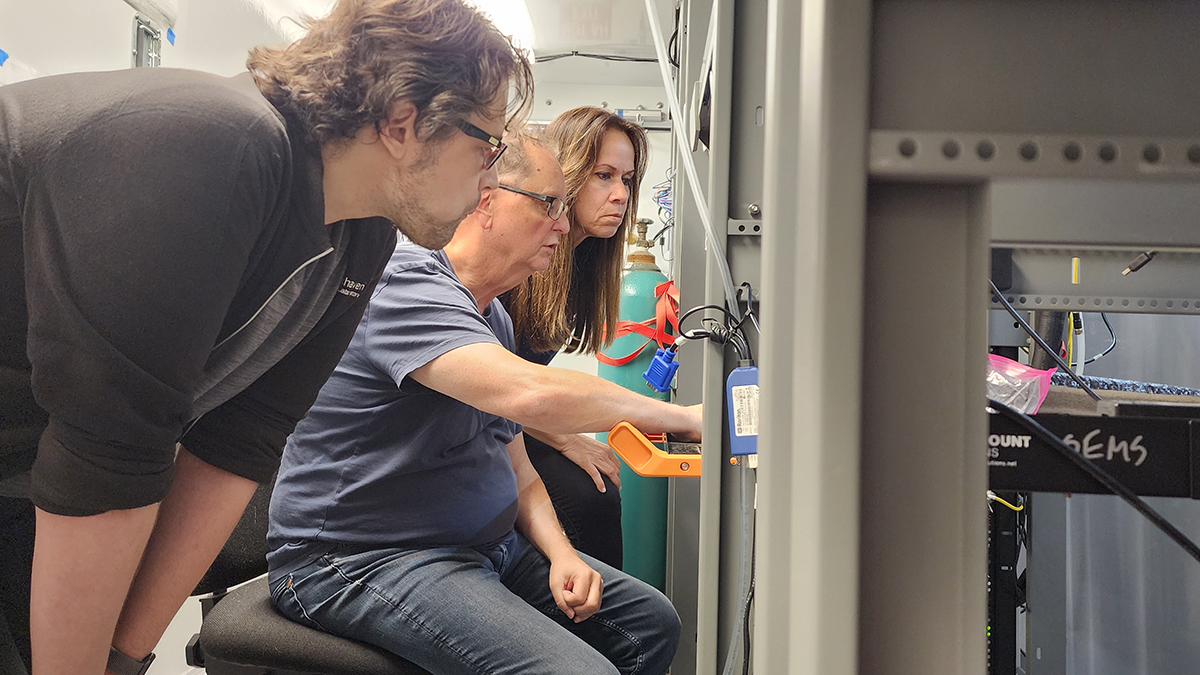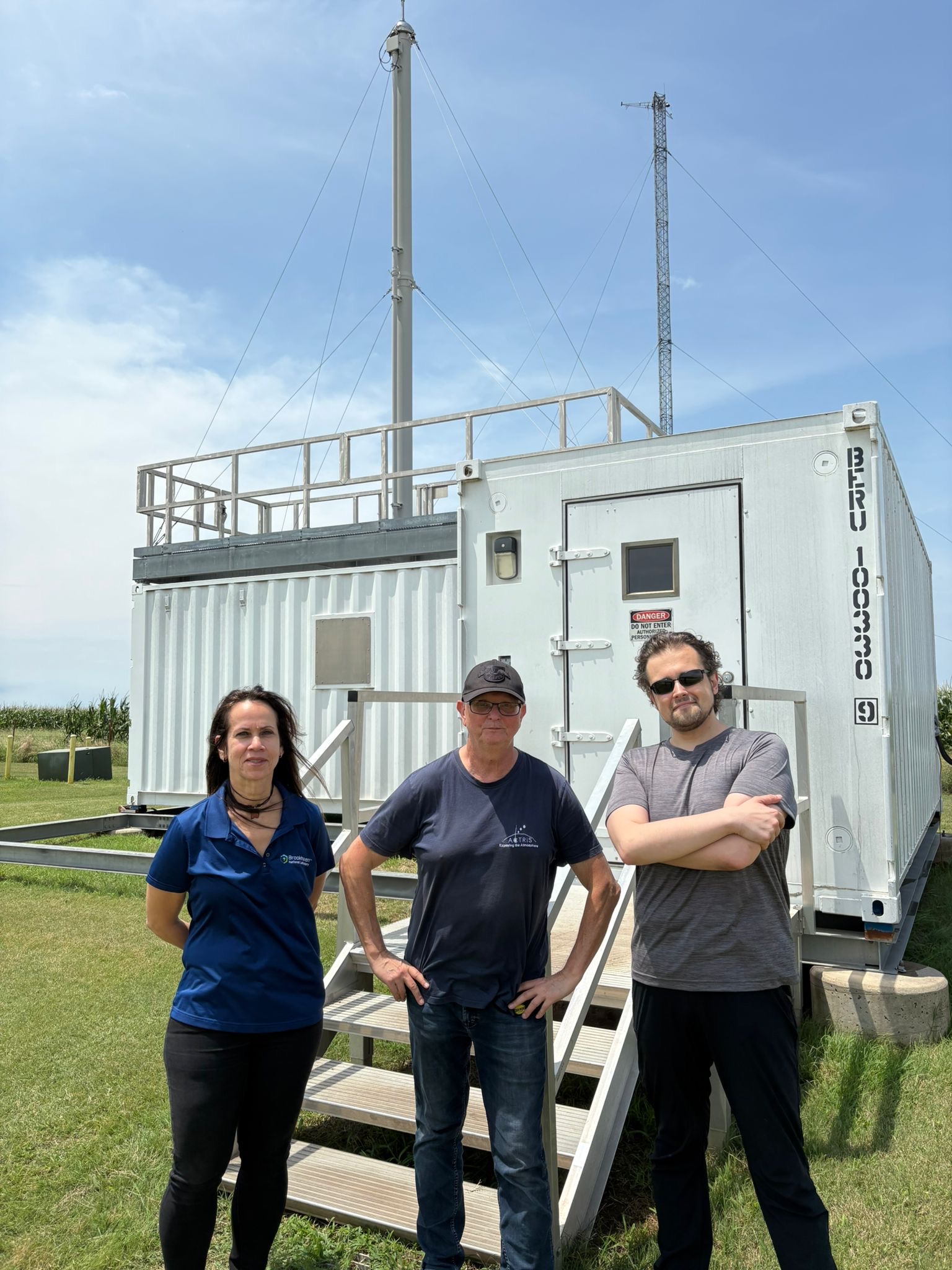SGP Aerosol Observing System Gets Excellent Review From Global Body
Published: 24 November 2025
World Calibration Centre for Aerosol Physics representative completes system audit

Since collecting its first byte of data over 30 years ago, the Atmospheric Radiation Measurement (ARM) User Facility has sought to ensure that its measurements meet the highest international standards, strengthening their consistency, comparability, and long-term scientific value.
In July 2025, ARM staff welcomed a representative from the World Calibration Centre for Aerosol Physics (WCCAP) to the Southern Great Plains (SGP) atmospheric observatory in Oklahoma for an audit of its Aerosol Observing System (AOS).
The WCCAP performs audits of aerosol monitoring sites around the world to ensure their data quality and consistency. It supports the World Meteorological Organization’s Global Atmosphere Watch (GAW) program, which coordinates long-term, high-quality observations of aerosols and atmospheric gases to improve understanding of atmospheric composition.
ARM AOS lead mentor Olga Mayol-Bracero, who serves on the World Meteorological Organization’s Scientific Advisory Group on Aerosols, helped facilitate the initial conversations about having an audit done at the SGP.
“I fully recognize the value of these audits and how meaningful this could be for ARM’s flagship observatory and the AOS,” she says.
Mayol-Bracero, ARM aerosol instrument mentor Janek Uin, and ARM Instrument Operations Manager Adam Theisen joined WCCAP representative Alfred “Ali” Wiedensohler at the SGP for the July 17 audit. SGP Manager Mark Spychala, who attended parts of the morning audit, and ARM science translator Scott Collis participated in some afternoon discussions with the group.
In the audit report that Mayol-Bracero received September 30, Wiedensohler congratulated the ARM SGP aerosol in situ measurement program for being in excellent condition. The report also included a set of recommendations and possible improvements for ARM to consider.
“Most of the recommendations provided in the evaluation were constructive and aligned with our ongoing efforts,” says Mayol-Bracero.
Audit Focus and General Report Comments

The audit focused on the AOS stack inlet; particle number concentration (greater than 10 nanometers [nm]); particle number size distributions (10–800 nm and 0.8–10 micrometers); cloud condensation nuclei number concentration; light scattering and absorption; and the aerosol chemical speciation monitor, which measures mass concentrations of non-refractory—or rapidly evaporating—organic and inorganic particles.
Overall, Wiedensohler found that:
- The SGP, which has operated since 1992 and collected aerosol data since 1996, is an established observatory.
- The laboratory and infrastructure are in excellent shape.
- The operation of the aerosol in situ measurements is ensured by highly qualified people.
- The ARM container that hosts the AOS instruments is well structured and maintained by staff at Brookhaven National Laboratory in New York, where most of ARM’s aerosol instrument mentors are based, and at the SGP.
- The minimum requirements for the number of variables needed to qualify as an aerosol in situ program at a GAW measurement station are fulfilled.
For a site to be designated as a GAW station, it must be registered in the GAW Station Information System, and an application letter requesting designation must be submitted to the GAW secretariat.
The GAW program has different sets of requirements that sites must meet to be designated as global, regional, mobile, or local stations. ARM is exploring the process of applying to have the SGP designated as a global station—in the highest tier—because of its extensive measurements.
The SGP was a GAW station from 1996 to 2017, when NOAA operated the AOS.
Audit Recommendations and Next Steps
The audit report included the following recommendations:
- Improve the drying efficiency for optical instrumentation during the summer.
- At the exit of each dryer, install a temperature/relative humidity sensor to monitor these data for all instruments.
- Install a separate inlet for nanoparticle measurements because losses of nanoparticles in the size range below 10 nm might be significant.
- Provide a calculation of particle losses for the coarse size range.
- Because of possible increased uncertainty in the nano-mobility particle size spectrometer size distribution for particles larger than 40 nm, restrict the size range of the nano-scanning mobility particle sizer to 2.5–40 nm (or up to 50 nm) while retaining the same time resolution to improve the counting statistics.
While some of the recommended actions, such as installing temperature/relative humidity sensors across the AOS and quantifying sample losses, are underway or planned for implementation, other recommendations regarding possible changes to AOS infrastructure and operations require further evaluation. ARM management is in the process of reviewing these recommendations, including with the Aerosol Measurement Science Group, a constituent group of experts from ARM and the atmospheric science community.
Keep up with the Atmospheric Observer
Updates on ARM news, events, and opportunities delivered to your inbox
ARM User Profile
ARM welcomes users from all institutions and nations. A free ARM user account is needed to access ARM data.


















